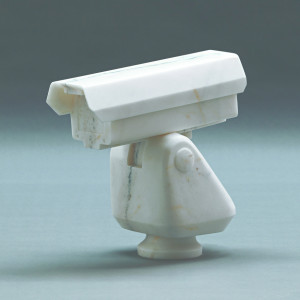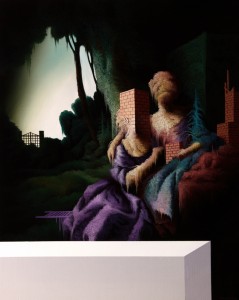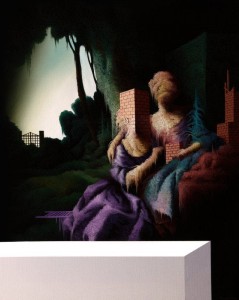This week FAD will be interviewing artists from the group show ‘System Failure’ which opens THIS Thursday . Here we have Ines Rebelo.
1. If you weren’t an artist, what else would you be?
I almost dropped Art College in my second year, to be a jazz musician. Not much of a change there, tough!
2. Can you tell us more about your work and what are the main ideas you would like to express?
For System Failure I am presenting 1 Attempt to Find the Snark #5 (2013) and DIY (night sky experience) (2013), an installation and a drawing, both using the constellations as the main motif.
1 Attempt to Find the Snark #5 is visible on a blank standalone gallery wall, where I perforated the planisphere of the constellations, one on each side. There are different drill-sized holes to reflect the intensity of the various stars. Conceptually, I was interested in making the standard gallery wall and the act of drilling be something else on their own, and not just subsidiary surface and action to support ‘artworks’. In the execution, I decided to have a full sized top to bottom planisphere as to surround the viewer as much as possible and create a sense of space with minimum elements: a flat white surface and pointillated dots.
DIY (night sky experience) is my latest drawing in a series that started in 2007, especially made for this exhibition to accompany the installation 1 Attempt to Find the Snark #5. It uses the same motif of the constellations, with a different purpose. As I was made aware of a group of posters distributed for free from The Guardian, I became interested in the collection. From the collection, there were a couple of wallcharts that drew my attention, one of which was ‘The Night Sky’. Not only I was visually interested in the contrast between the pitch-black background, the white words and the yellow dots, but I was also interested in the simple fact that each night sky is different (unlike the posters, repeated mechanically), although all night skies can be charted equally. Sometimes, in the middle of the night we can’t see clearly, the stars are there, and we know they are, but we can only see glimpses of light as our vision is literally clouded. In the drawing, I wanted to juxtapose a subjective experience of a cloudy night, to the objective register of the map of the constellations.
3. How do you start the process of making work?
In my work, my ideas tend to direct my execution, and guide my process of decision-making. I’m not driven by pure experimentation with materials in the studio, although I enjoy making my own work. Generally, I don’t tend to start making a piece before I have an idea, and maybe that’s why I work in different mediums from painting and drawing to installation. Some ideas seem more suitable in one medium, and others make sense in another.
4. Do you consider the viewer, when making your work?
Ultimately, the viewer makes the work, that’s for sure. The work only exists with someone, not by itself. Depending on the piece, the degree of consideration varies. Some of my works place more direct emphasis on the viewer, sometimes asking the spectator to physically engage with the work. As an example, and perhaps one of my first pieces to invite the viewer more openly to ‘interaction’ is ScopeTele (2007).
This work was constituted by two telescopes placed in front of each other, with drawings of observed faraway landscapes on their main cylindrical body. By looking through one of them, the spectator could see the interior of the other telescope or someone else’s gaze at the other end. In this way, the function of a telescope was disrupted as the experience of looking far away through powerful lenses was folded back to an almost intimate encounter at eye-level.
5. What defines something as a work of art?
Something that isn’t.
6 . What’s next for you?
My next project will be shown at The Starseed Transmission, curated by Lucy A. Sames from ENCLAVE, included in Deptford X. The exhibition is put together to explore diagrams and ‘conversations’ between diagrams. It is inspired by the exchange of ideas between Carl Sagan (astronomer, astrophysicist and cosmologist) and Timothy Leary (writer, psychologist and LSD advocate) both of whom developed cosmologies that connected the map of the human mind with voyages through faraway galaxies.
Ines is exhibiting at ‘System Failure’ a group show presented by The Contemporary London opening this Thursday 29th August more details HERE







